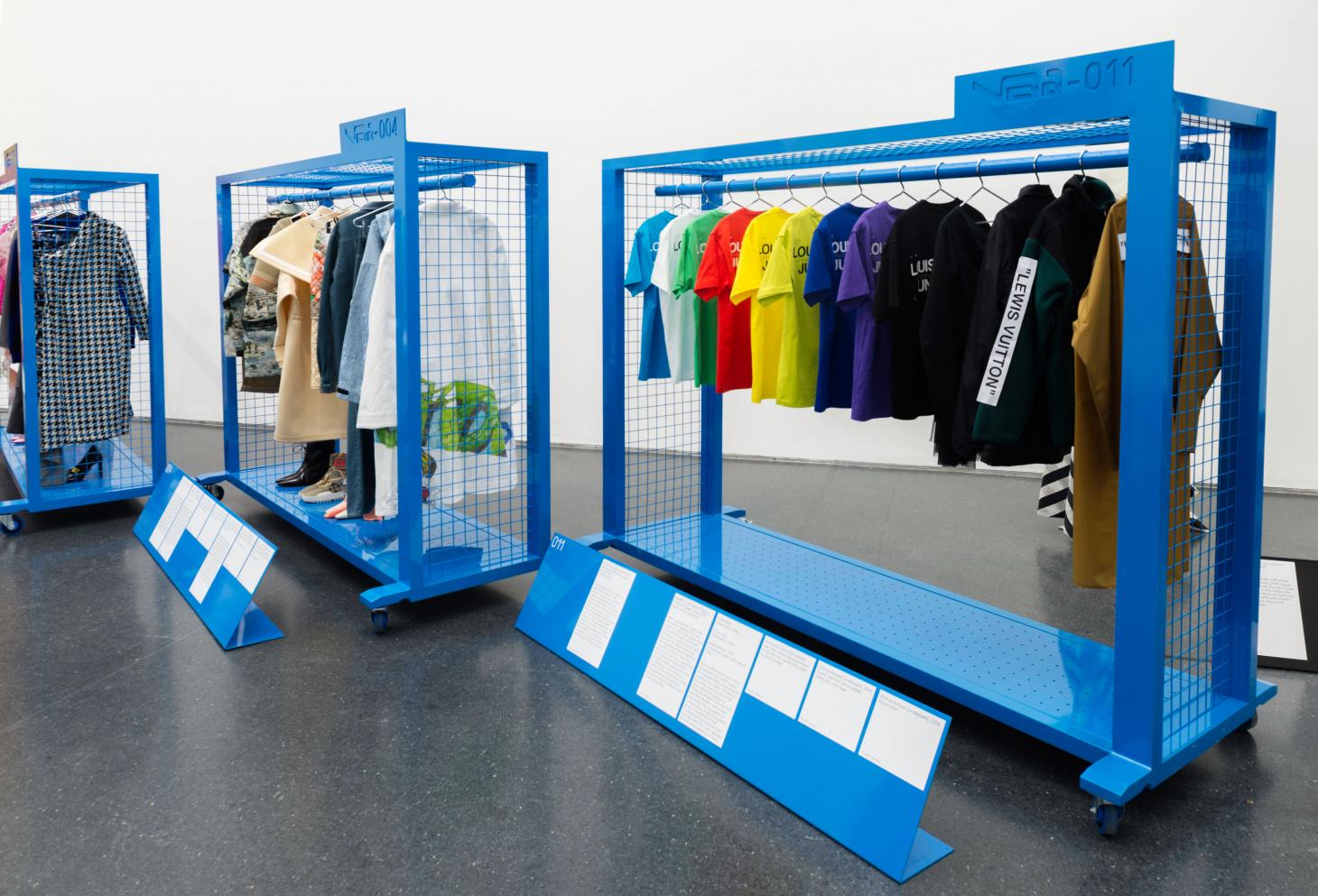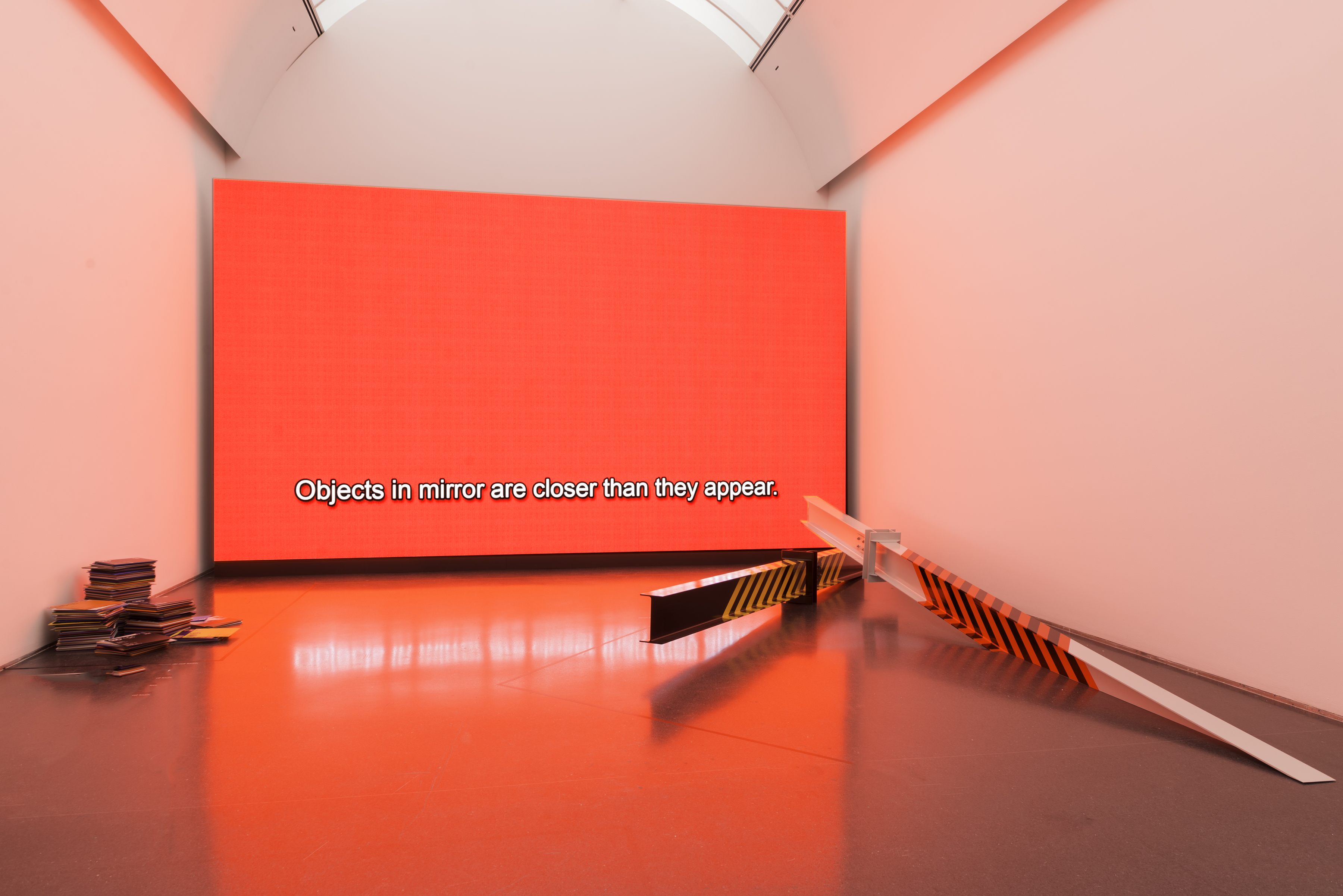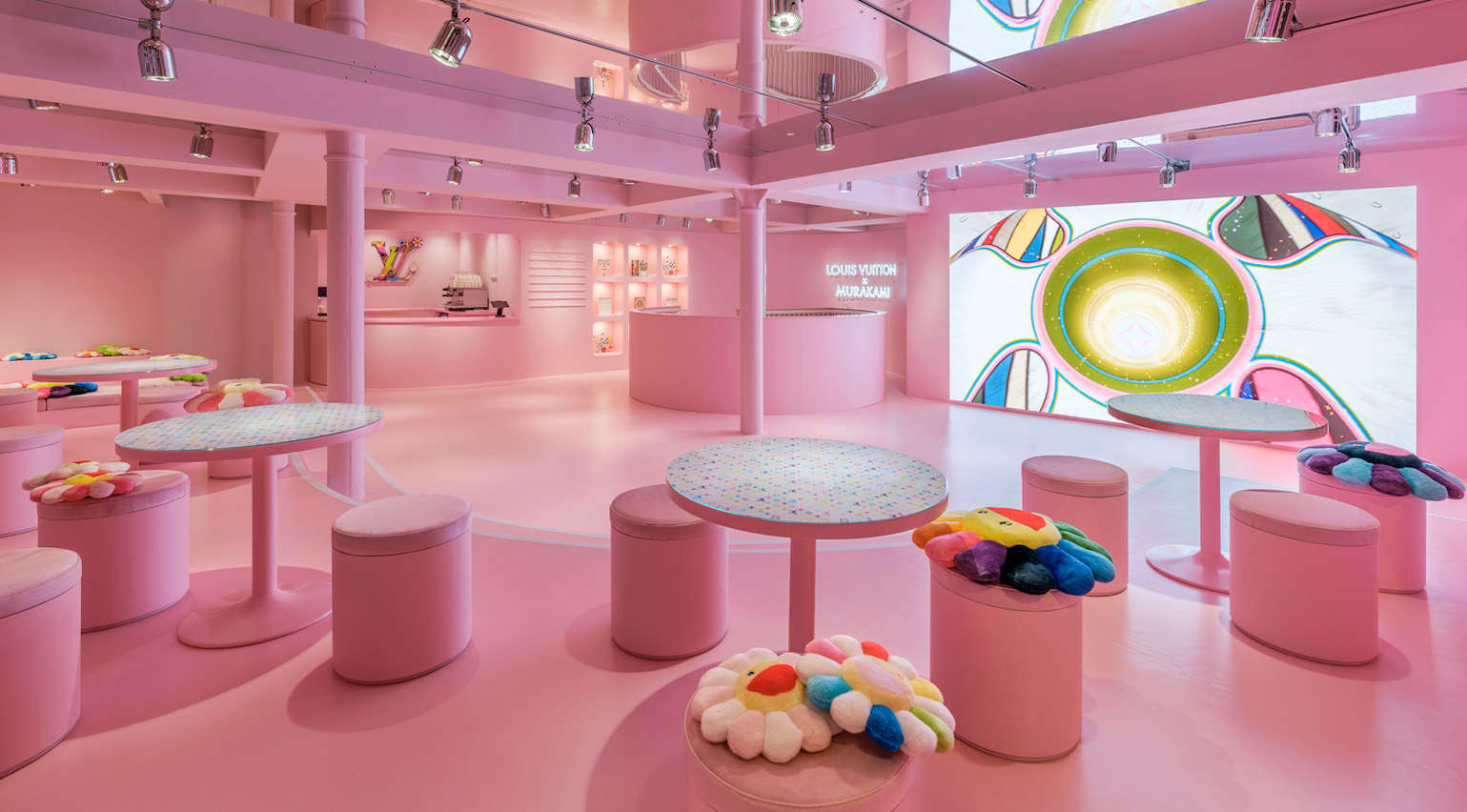Cheat sheet: MCA show decodes 20 years of Virgil Abloh

‘Twelve thousand square feet of exhibition space is still just scratching the surface of what Virgil has done for the past 20 years,’ says Michael Darling, chief curator at the Museum of Contemporary Art (MCA) Chicago, who scoped Virgil Abloh for the survey show – before his Louis Vuitton appointment as menswear director in 2018 – on the basis of holding up one of Chicago’s ‘local superstars’.
The exhibition is a bit of a ‘cheat code’ for understanding Abloh, the creative director, designer and polymath. It covers a lot of ground: his work with Kanye West as a product and graphic designer for 10 years, his DJ career, Off-White, Louis Vuitton, Ikea, and lots in between. ‘We have laid the ground work, so someone can come in after us,’ says Darling, in recognition that there will be much more to come.
Abloh and Darling teamed up with AMO’s head of design Samir Bantal to formulate and design the show. Four sections divide up Abloh’s offering from 1989 to date: Music, Fashion, Design and the Black Gaze – the final section ‘cuts through the hype and the buzz’ and ’brings to the surface the social commentary especially around race, that’s been there from the beginning,’ says Darling.

Wooden virtrine stamped with a Nike tick, holding jewellery Virgil Abloh for Jacob & Co
The buzz is represented by the graphic ‘culture wall’ that welcomes you into the exhibition – an ‘autobiographical, matrix of influences’ inspired by the visual identity of Rem Koolhaas’ 1978 book Delirious New York, featuring portraits, references and text.
Abloh’s relationship with Koolhaas and OMA goes back to when a new building was being built at the Illinois Institute of Technology campus when Abloh was an architecture student there. The relationship developed further when the pair sat down for an interview for System Magazine in 2017, and it was Abloh’s idea to get AMO involved in the exhibition.
Bantal describes the process of working with Abloh on the exhibition as akin to Nanggol (the original version of bungee jumping, performed as a ritual by the men of Vanuata – without the elastic line) and ‘almost strictly’ all collaboration was online: ‘endless threads of scrollable ideas free from location or time’ writes Bantal in the ‘Figure of Speech’ catalogue.
His work with Abloh and observations about his work led Bantal to conclude ‘the idea of the Prototype as an effective strategy’: ‘A prototype is open-ended and receptive to critique. A prototype is a perfect freeze of exploration, liberated from a definitive end goal,’ writes Bantal.

Nike trainer prototypes designed by Virgil Abloh
Walk around the exhibition with these words in mind. You’ll see Abloh fearlessly venturing from project to project, unafraid of failure or new pursuits, priding himself in his ability to be a ‘tourist’. ‘I’ve crafted my output into opening minds, instead of reaffirming closed minds,’ says Abloh in a conversation between Rem Koolhaas and Bantal, explaining his tourist/purist dichotomy. Some prototypes in the exhibition feel like finished works, others feel like the start of something exciting, and some probably made it off the drawing board slightly prematurely, but such is life.
Abloh’s IKEA furniture design prototypes are piled up in the exhibition ready for a bonfire. They are reverse prototypes, taking history and working forwards, summarising, simplifying and stripping back – representing Abloh’s interest in opening up classic 20th century design (think Prouve, Le Corbusier and Nakoshima) to a millennial consumer audience. These works also interrogate his interest in copyright law, public domain and fair usage. ‘A couple of the rugs made it into the world’ says Darling, as we observe the pyre.
RELATED STORY

Instead of prototypes, some works look more like props. Fake functional objects wheeled out from backstage at the Virgil Abloh show. A billboard spelling out ‘Advertise here’ with graffiti on the back. Concrete style graffitied furniture pieces and a reflective, high-gloss stainless steel iPhone-shaped mirror for Kreo. Diamond studded paper-clip jewellery for Jacob & Co. These objects nod to Abloh’s formative years as a skateboarder in suburban Chicago.
While a T-shirt could feel like a prototype, Abloh makes it a work of art. T-shirt screen-printing frames hang on the walls like masterpieces. One framed Supreme t-shirt in the show has never been worn, and only ever displayed in a frame in a museum. From his early t-shirt printing ventures with J Boogie in Chicago as a teen skater, to making merchandise with Kanye West, to designing the Pyrex 23 t-shirts (a comment on young black men, drug culture and Michael Jordan), to his work with re-used Champion and Ralph Lauren flannel tees, working with Shayne Oliver from Hood by Air, Off-White staples, and pieces for Louis Vuitton – such as an unreleased tie-dye Pistolesi leather t-shirt for Men’s SS19 seen in the show, or a simple black and white staff t-shirt for the first runway show. The t-shirt is a medium that Abloh has mastered.

Supreme t-shirt by Virgil Abloh
A whole set of unreleased Nike trainer prototypes on a low plinth are also works of art – studded, bulbous beauties, labeled “prototype”, smooth and contoured in phoenix red or bulky dinosaurs in grey and transparent plastic. The trainers don’t feel like throw-away prototypes, they are there to be studied and savoured.
More than anything, the exhibition shows how Abloh approaches fashion as an artist. As creative director of Off-White launched in 2013, and artistic director of menswear at Louis Vuitton, from March 2018, he has worked to embed concepts and thinking into collections, campaigns and runway shows. The exhibition presents artefacts and remnants of these – a bright yellow neon sign used in his first Off-White runway show in Paris (F/W 16) reading ‘You’re obviously in the wrong place’. Or his first campaign images for Louis Vuitton shot by Inez and Vinoodh featuring children of colour playing with luxury Louis Vuitton products.

Clothes designed by Virgil Abloh on bright blue rails designed by AMO
Abloh is saying a lot: the A/W 2019 collection titled ‘Sliding, backwards, slowly’ featured rubber coated LV-branded neon gloves and a shirt and pants featuring graphics from The Wiz cartoon, that adapts the Wizard of Oz from an African-American perspective. In the final room, the ‘Keep all’ LV bag with a hefty orange chain to keep it safe, speaks of who he is in the world, and how the luxury industry perceives young black males walking into an LV store. Abloh’s ‘black gaze’ that runs throughout the exhibition and infiltrates his work is personal, but it also feels universal in many ways. He brings a perspective that echoes that of many.
Right now, we are still caught up in who Abloh is, but after seeing this exhibition, maybe you'll start thinking more about what he is actually saying. Abloh summarises in the final conversation of the catalogue spoken to founder and editor-in-chief of Vestoj, Anja Aronowsky Cronberg: ‘...My goal is to disappear and let the work speak for itself.’
Wallpaper* Newsletter
Receive our daily digest of inspiration, escapism and design stories from around the world direct to your inbox.





INFORMATION
Virgil Abloh: "Figures of Speech" , MCA, 10 June to 22 September 22, 2019
mcachicago.org
Harriet Thorpe is a writer, journalist and editor covering architecture, design and culture, with particular interest in sustainability, 20th-century architecture and community. After studying History of Art at the School of Oriental and African Studies (SOAS) and Journalism at City University in London, she developed her interest in architecture working at Wallpaper* magazine and today contributes to Wallpaper*, The World of Interiors and Icon magazine, amongst other titles. She is author of The Sustainable City (2022, Hoxton Mini Press), a book about sustainable architecture in London, and the Modern Cambridge Map (2023, Blue Crow Media), a map of 20th-century architecture in Cambridge, the city where she grew up.
-
 All-In is the Paris-based label making full-force fashion for main character dressing
All-In is the Paris-based label making full-force fashion for main character dressingPart of our monthly Uprising series, Wallpaper* meets Benjamin Barron and Bror August Vestbø of All-In, the LVMH Prize-nominated label which bases its collections on a riotous cast of characters – real and imagined
By Orla Brennan
-
 Maserati joins forces with Giorgetti for a turbo-charged relationship
Maserati joins forces with Giorgetti for a turbo-charged relationshipAnnouncing their marriage during Milan Design Week, the brands unveiled a collection, a car and a long term commitment
By Hugo Macdonald
-
 Through an innovative new training program, Poltrona Frau aims to safeguard Italian craft
Through an innovative new training program, Poltrona Frau aims to safeguard Italian craftThe heritage furniture manufacturer is training a new generation of leather artisans
By Cristina Kiran Piotti
-
 Inside Louis Vuitton’s Murakami London pop-up, a colourful cartoon wonderland with one-of-a-kind café
Inside Louis Vuitton’s Murakami London pop-up, a colourful cartoon wonderland with one-of-a-kind caféWallpaper* takes a tour of the Louis Vuitton x Murakami pop-up in London’s Soho, which celebrates the launch of a new ‘re-edition’ accessories collection spanning the greatest hits from the Japanese artist’s long-running collaboration with the house
By Jack Moss
-
 Scene-stealing runway sets from A/W 2022 menswear shows
Scene-stealing runway sets from A/W 2022 menswear showsA Kubrickian space odyssey at Prada; a recreation of the Pont Alexandre III in Paris at Dior; and colourful, artist-created flags at Loewe: explore the best runway sets from the A/W 2022 menswear shows
By Laura Hawkins
-
 Paris Fashion Week Men’s A/W 2022: Louis Vuitton to Loewe, Dior to Hermès
Paris Fashion Week Men’s A/W 2022: Louis Vuitton to Loewe, Dior to HermèsIn this extended report, Laura Hawkins reveals 9 highlights from Paris Fashion Week Men's A/W 2022. Including: Virgil Abloh's final collection for Louis Vuitton; Rick Owen's riff on sleaze; elfin-inspired accessories; and a celebration of slouch and surrealism
By Laura Hawkins
-
 Louis Vuitton pays tribute to Virgil Abloh in Miami
Louis Vuitton pays tribute to Virgil Abloh in MiamiThe French luxury maison – of which the late Virgil Abloh was men’s artistic director until his passing on Sunday 28 November 2021 – held a show in Miami in tribute to the creative innovator, titled ‘Virgil was Here’
By Laura Hawkins
-
 Virgil Abloh to Dior: fashion must-sees in Doha
Virgil Abloh to Dior: fashion must-sees in DohaThe Qatari capital Doha plays host to a duo of blockbuster retrospective fashion exhibitions, ‘Virgil Abloh: Figures of Speech’ and ‘Christian Dior: Designer of Dreams’
By Laura Hawkins
-
 Sarah Moon brings painterly fashion and dark fantasy to Fotografiska New York
Sarah Moon brings painterly fashion and dark fantasy to Fotografiska New YorkOctogenarian French photographer and filmmaker Sarah Moon shows 30 years of work at Fotografiska New York – spanning fashion and fantasy, mystery and the macabre, it’s dark, painterly and compelling
By Pei-Ru Keh
-
 ‘In America: A Lexicon of American Fashion' is coming to The Met
‘In America: A Lexicon of American Fashion' is coming to The MetThe first of a two-part, year-long extravaganza, ‘In America: A Lexicon of American Fashion’ is organised into 12 sections that seek to define the emotional qualities in American style
By Pei-Ru Keh
-
 Saint Laurent celebrates 40 years of Memphis Group
Saint Laurent celebrates 40 years of Memphis GroupMemphis Group's milestone birthday is celebrated with a series of colourful furniture installations across the French maison's concept boutiques
By Laura Hawkins